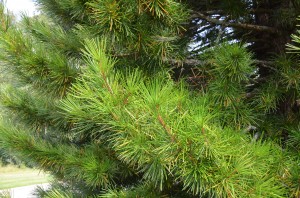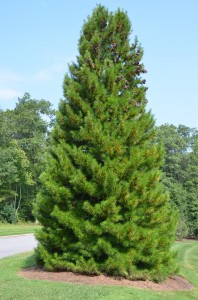Umbrella pine (Sciadopitys verticillata) is an outstanding evergreen large shrub or medium-sized pyramidal tree. Initially, umbrella pine grows slowly, only 6 to 8 inches annually, but growth rate picks up after 4-5 years. A young 3-foot tall plant may reach 20 to 30 feet tall in 25 years and double that at maturity.
Its leaves are unique–dark green, 2 to 5 inches long, flat glossy needles. Leaves are thick and wide, and rarely turn off-color in Southern Appalachian winters (USDA hardiness zones 6 and 7). Clusters of 20 to 30 long flat needles are arranged like the spokes of a wheel or an umbrella. Needles are retained 3 or more years; the old needles shed and neatly pile up on the ground as mulch.
Umbrella pine prefers one-half to full day sun planted in compost-rich, moist, well-drained, acidic soil. Provide moderate afternoon shade against summer heat in zone 7. Umbrella pine is a fossil tree and has survived through geologic time to ward off disease or insect pests. Pruning is rarely a chore, perhaps to remove multiple leaders or a small dead twig.
No two umbrella pines look alike and their growth rates are quite variable. Trees reach cone-bearing age in approximately 20 years. The 1-inch long flowers and 2-4 inch green cones are of little ornamental value. The shaggy reddish brown bark on a 25 year and older tree exfoliates in long narrow strips.
Umbrella pine is not commonly sold garden centers and are expensive. ‘Aurea’ (gold needle), ‘Mitsch Select’ (dwarf), and ‘Pendula’ (weeping) forms are available from select e-commerce nurseries. Locate an umbrella pine where you achieve the best visual impact such as adjacent to a patio or deck.
Not a true pine (Pinus spp.), umbrella pine is closely akin to yew (Taxus spp.). Its long flat needled leaves are found embedded in fossil rocks from prehistoric Europe, Canada and Greenland.



 Posted in
Posted in 
